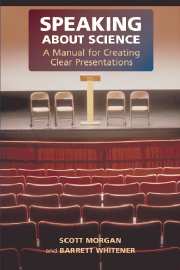Book contents
- Frontmatter
- Contents
- ACKNOWLEDGMENTS
- INTRODUCTION
- 1 THE BASIC PROBLEM WITH ORAL PRESENTATIONS, AND ITS SOLUTION
- 2 THE FIRST STEPS OF PREPARATION
- 3 SELECTING HELPFUL IMAGES
- 4 BEGINNING AND ENDING THE PRESENTATION
- 5 TITLING THE TALK
- AT A GLANCE: THE SEVEN SIGNPOSTS
- AT A GLANCE: 15 KEYS FOR SUCCESS BEHIND THE PODIUM
- IN CLOSING
- APPENDIX 1 FULL INTRODUCTIONS
- APPENDIX 2 POSTERS
- Index
2 - THE FIRST STEPS OF PREPARATION
Published online by Cambridge University Press: 04 August 2010
- Frontmatter
- Contents
- ACKNOWLEDGMENTS
- INTRODUCTION
- 1 THE BASIC PROBLEM WITH ORAL PRESENTATIONS, AND ITS SOLUTION
- 2 THE FIRST STEPS OF PREPARATION
- 3 SELECTING HELPFUL IMAGES
- 4 BEGINNING AND ENDING THE PRESENTATION
- 5 TITLING THE TALK
- AT A GLANCE: THE SEVEN SIGNPOSTS
- AT A GLANCE: 15 KEYS FOR SUCCESS BEHIND THE PODIUM
- IN CLOSING
- APPENDIX 1 FULL INTRODUCTIONS
- APPENDIX 2 POSTERS
- Index
Summary
Theories are nets cast to catch what we call “the world” … We endeavor to make the mesh ever finer and finer.
– Sir Karl Popper, The Logic of Scientific Discovery (1959)Perhaps the following preparation process will look familiar to many speakers: After receiving an invitation to speak, the presenter chooses a title; writes the introduction; searches the data; sorts the slides; and finally, summarizes the conclusion points on a slide.
Scott Morgan used to prepare his talks this way. When he attended a presentation, he would hear the title, introduction, data and conclusion points, and assume they should be prepared in the same order.
But there are several drawbacks to this common strategy. First, there is probably more information to share than available speaking time in which to share it. For a speaker to fit her remarks into the allotted time, she must eliminate some interesting and perhaps essential facts. But perhaps the biggest drawback is that she drowns the talk's central point in the minutiae of excessive detail. As a result, the talk is longer and more detailed than an audience can readily accommodate. No wonder the list of common complaints about talks includes “too complicated” and “too much information.”
Mr. Morgan eventually realized that as linear as the preparation process seemed, his own groundwork was actually very different. It was also less time consuming.
Information
- Type
- Chapter
- Information
- Speaking about ScienceA Manual for Creating Clear Presentations, pp. 9 - 16Publisher: Cambridge University PressPrint publication year: 2006
